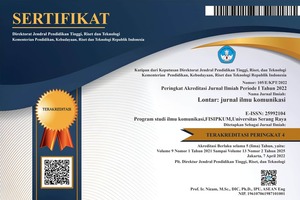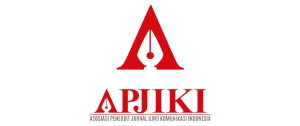Crisis Response Strategy of PT. Angkasa Pura II on the News of Health Protocol Violations at Soekarno-Hatta Airport
DOI:
https://doi.org/10.30656/lontar.v11i1.6308Keywords:
Angkasa Pura II, Covid-19, Crisis Communication, Crisis Response Strategy, Health ProtocolAbstract
Thursday, May 14th, 2020, the public was shocked by the occurrences of violations of health protocol during the pandemic Covid-19 at Soekarno-Hatta Airport. At that time, the government was relaxing the Large-Scale Social Restrictions (PSBB) by re-activating public transportation modes. Reports in the mass media and social media cornered PT. Angkasa Pura II, the airport administrator, is a party that is negligent in managing flight schedules and rules for maintaining distance at the airport. This research objective was to identify the crisis response strategy carried out by PT Angkasa Pura II to overcome the negative news resulting from the incident of health protocol violations at Soekarno-Hatta Airport. The study discusses crisis response strategies derived from Situational Crisis Communication Theory (SCCT). This research method is qualitative. Research data was obtained through interviews, observation, and literature study. The results of this research, AP II crisis response strategies were, (1) rebuilding, the rebuilding response strategy AP II was conducted with an apology. (2) Take corrective actions, AP II made some physical improvements, increasing field staff and warning signs for applicating health protocols in public spaces. And (3) diminishment, the diminishment response strategy AP II was conducted by submitting excuses and justifications. AP II attempts crisis framing by disseminating information about the company's efforts and commitments that are disseminated through the company's website and social media. This step aims to make the public aware of the company's positive efforts to deal with the crisis and the public also understands that AP II has no intention of committing violations.
References
Adkins, G. L. (2010). Organizational Networks In Disaster Response: An Examination Of The Us Government Network’s Efforts In Hurricane Katrina. In The handbook of crisis communication (pp. 93–114). Wileyâ€Blackwell Oxford, UK.
Billings, R. S., Milburn, T. W., & Schaalman, M. Lou. (1980). A Model Of Crisis Perception: A Theoretical And Empirical Analysis. Administrative Science Quarterly, 300–316.
Bogdan, R. C., & Biklen, K. S. (1982). Qualitative Research for Education: An Introduction to Theory and Methods. London: Allyn and Bacon, Inc.
Coombs, W. T. (2007a). Ongoing Crisis Communication: Planning, Managing and Responding. Thousand Oaks, CA: Sage.
Coombs, W. T. (2007b). Protecting Organization Reputations During a Crisis: The Development and Application of Situational Crisis Communication Theory. Corporate Reputation Review, 10, 163–176.
Coombs, W. T., & Holladay, S. J. (2002). Helping Crisis Managers Protect Reputational Assets: Initial Tests Of The Situational Crisis Communication Theory. Management Communication Quarterly, 16(2), 165–186.
Coombs, W. T., & Holladay, S. J. (2010). The Handbook of Crisis Communication. United Kingdom: Wiley-Blackwell.
Darussalam, A. D., Sugiyanto, D. R., & Lubis, D. P. (2021). Analisis Krisis Public Relations Pada Peristiwa Tumbangnya Pohon di Kebun Raya Bogor. PRofesi Humas, 5(2), 251–269.
Farianingrum, A., & Istiyanto, S. B. (2021). Krisis Sebagai Akselerator Layanan Komunikasi Instansi Publik Di Masa Pandemi. LONTAR: Jurnal Ilmu Komunikasi, 9(1), 1–8.
Gugus Tugas Percepatan Penanganan Covid-19. (2020). Info Grafis Covid 14-19 Mei 2020. Retrieved from https://covid19.go.id/p/berita/infografis-covid-19-14-mei-2020
Hartomo, G. (2020). Penumpang Numpuk, Ombudsman: Koordinasi AP II Buruk di Bandara Soetta. Retrieved from OkeFinance website: https://economy.okezone.com/read/2020/05/14/320/2213967/penumpang-numpuk-ombudsman-koordinasi-ap-ii-buruk-di-bandara-soetta
Holladay, S. J. (2010). Are They Practicing What We Are Preaching? An Investigation Of Crisis Communication Strategies in The Media Coverage of Chemical Accidents. In The handbook of crisis communication (pp. 159–180). Blackwell Publishing Ltd. West Sussex, UK.
Iqbal, M. (2020). Picu Orang Menyemut di Soetta, Batik Air & AP II Kena Sanksi. Retrieved from CNBC Indonesia website: https://www.cnbcindonesia.com/news/20200519215000-4-159689/picu-orang-menyemut-di-soetta-batik-air-ap-ii-kena-sanksi
Kennardy, G. (2016). Komunikasi Krisis PT Kalbe Farma Dalam Menangani Kasus Kesalahan Pelabelan Obat Buvanest Spinal. Tangerang: Universitas Multimedia Nusantara.
Kriyantono, R. (2012). Measuring a Company Reputation In a Crisis Situation: An Ethnography Approach on The Situational Crisis Communication Theory. International Journal of Business and Social Science, 3(9).
Meyerding, S. G. H., Spiwoks, E., Rombach, M., & Lehberger, M. (2019). Not Only Speed Matters–Crisis Response in The Hypothetical Case of a Transport Accident Involving Genetically Modified Crops. Food Policy, 85, 55–63.
Nova, F. (2011). Crisis Public Relations Bagaimana PR Menangani Krisis. Jakarta: Raja Grafindo Persada.
PT. Angkasa Pura II. (2020a). Annual Report PT Angkasa Pura II. Retrieved from https://www.angkasapura2.co.id/en/investor_relation?activeTab=report
PT. Angkasa Pura II. (2020b). Dokumentasi PT Angkasa Pura II. Retrieved from Instagram Angkasa Pura II website: https://www.instagram.com/angkasapura2/
PT. Angkasa Pura II. (2020c). Tentang Kami. Retrieved from https://angkasapura2.co.id/id/about?activeTab=visionmission
Putri, L. D. (2014). Krisis, Ancaman atau Peluang?! LONTAR: Jurnal Ilmu Komunikasi, 3(1).
Rani, C. (2020). Penumpukan Penumpang di Bandara Soekarno-Hatta, Warganet: Sia-sia Sudah PSBB Selama Ini. Retrieved from Netray’s Blog website: https://blog.netray.id/penumpukan-penumpang-di-bandara-soekarno-hatta-warganet-sia-sia-sudah-psbb-selama-ini/
Reza, T. (2020). Viral Antrean di Terminal 2 Bandara Soetta, Pihak Bandara Minta Maaf. Retrieved from Kompas TV website: https://www.kompas.tv/article/81213/viral-antrean-di-terminal-2-bandara-soetta-pihak-bandara-minta-maaf
Rifa’i, B. (2020). Bandara Soetta Padat, Gubernur Banten Peringatkan Angkasa Pura II. Retrieved from Detik News website: https://news.detik.com/berita-jawa-barat/d-5016588/bandara-soetta-padat-gubernur-banten-peringatkan-angkasa-pura-ii
Sugiyono. (2021). Metode Penelitian Kuantitatif, Kualitatif dan R&D (13th ed.). Bandung: Alfabeta.
Suryani, I., & Sagiyanto, A. (2018). Strategi Manajemen Krisis Public Relations PT Blue Bird Group. Communication, 9(1), 103–113.
Wulandari, T. D. (2011). Pengaruh Tanggung Jawab Perusahaan dalam Menanggulangi Krisis Terhadap Reputasi Perusahaan. Jurnal Ilmu Komunikasi, 8(2).
Yasin, A. (2020). Tweet Terkait Pelanggaran Protokol Kesehatan di Bandara Soekarno-Hatta. Retrieved from https://twitter.com/adriansyahyasin/status/1260760025951158273
Downloads
Published
Issue
Section
License
By submitting an article to the journal, the author(s) agree to transfer the published article's copyright to the journal, which will act as the publisher. This means the journal will have the right to publish the article in various forms, including reprints. The journal will maintain the publishing rights to the published articles.
In line with the license, authors and third parties (readers, researchers, and others) are allowed to share and adapt the material. In addition, the material must be given appropriate credit, provided with a link to the license, and indicated if changes were made. If authors remix, transform, or build upon the material, authors must distribute their contributions under the same license as the original.





